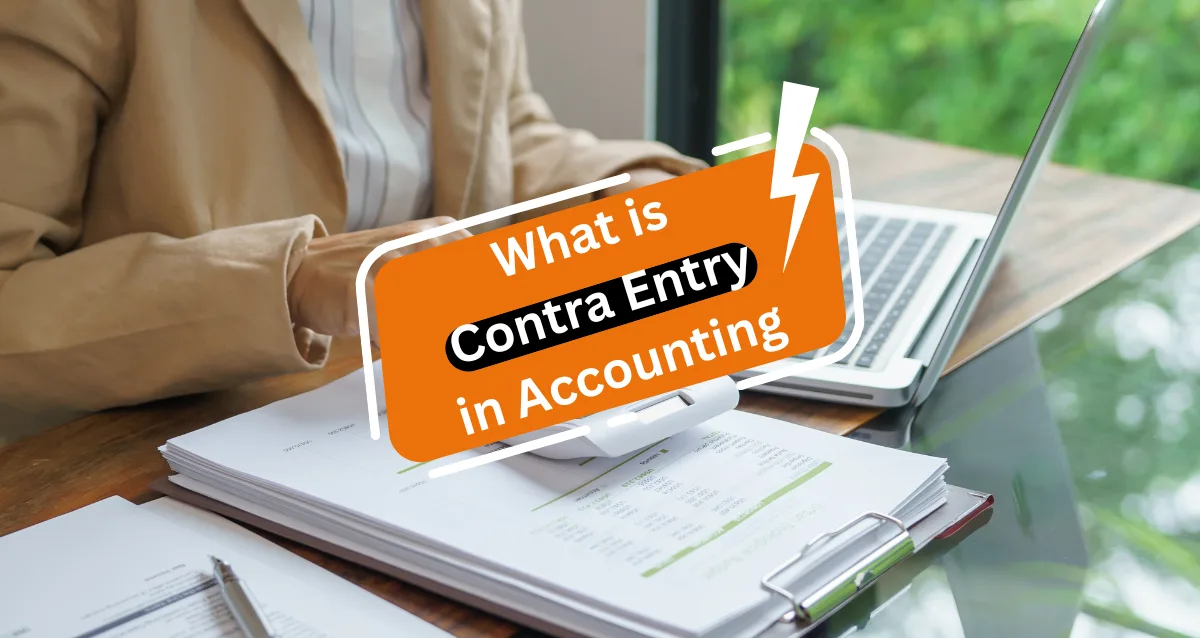What is Contra Entry in Accounting? Examples and Format
Understanding contra entry in accounting is important for business owners, accountants, students, and professionals who want clarity in financial reporting. Whether a company operates in the UAE, India, or any international location, contra entries play an essential role in maintaining clean and accurate cash book and banking records. For Indian entrepreneurs who operate or plan to operate businesses in the UAE, learning how contra entries work helps in managing daily transactions, preparing correct accounting statements, and ensuring compliance with financial standards in both countries.
Contra entries may look confusing at first, especially for beginners or students in class 11, but once you understand the meaning, purpose, and format, they become one of the easiest accounting concepts to apply. This guide explains the meaning of contra entry in simple, human language and also covers examples, journal formats, ledger treatment, tally usage, and common situations where contra voucher entries are used.
By the end of this guide, Indian readers will understand what a contra entry is, why it matters, how to record it, and how it helps maintain transparency in cash and bank accounts. Businesses operating between India and the UAE can also use this knowledge to improve accounting accuracy and avoid errors.
What is Contra Entry in Accounting
Contra entry in accounting refers to a special type of entry used in the cash book when cash and bank transactions affect each other. It is recorded when one part of the transaction occurs in the cash account and the other part occurs in the bank account. Since both accounts belong to the same business, the transaction does not affect external parties. Therefore, the entry is recorded only in the cash book and not in the general journal.
Contra entries are used in situations such as cash deposited into the bank, cash withdrawn from the bank for office use, bank withdrawals for petty cash, transfers between different bank accounts of the same business, or cash received back from the bank. These transactions do not increase or decrease the overall assets of the business; they only shift the form from cash to bank or bank to cash.
Contra Entry Meaning Explained Simply
Contra entry meaning is simple. It refers to a transaction where cash and bank accounts are involved at the same time. When money moves between these two accounts, we call it a contra entry. The word contra means opposite. It indicates that one account is debited and another account is credited within the business itself.
For example, cash deposited into the bank decreases cash but increases bank balance. Similarly, cash withdrawn from the bank increases cash but decreases bank balance. These opposite movements make the entry a contra transaction.
Why Contra Entries Are Important
Contra entries help maintain accurate financial records and a clear understanding of cash flow. Businesses must record these transactions properly to avoid confusion, misstatements, or missing balances.
Some important reasons include:
- Accuracy in cash and bank balances
- Clear tracking of cash deposits and withdrawals
- Avoiding double counting in accounting
- Maintaining transparent financial records
Ensuring compliance with UAE and India accounting standards
For Indian businesses operating in the UAE, contra entries ensure that the company’s financial statements match the requirements of UAE auditors, banks, and regulatory authorities.
Define Contra Entry
To define contra entry, we can explain it as a bookkeeping entry recorded when a transaction impacts both cash and bank accounts simultaneously, without any impact on external parties. These entries are marked with the letter C to show that they are contra transactions.
Purpose of Contra Entry
The purpose of contra entry is to show internal movement of funds. It avoids unnecessary double entries in the journal and keeps the cash book updated. It ensures that cash and bank balances reflect the exact movement of money, making financial statements more reliable.
Contra Entry in Cash Book
The contra entry in cash book appears when money moves between cash and bank accounts. In a two column cash book or three column cash book, a contra entry is written on both debit and credit sides. One side shows cash deposited or withdrawn, and the other side shows the effect in the bank account.
Cash book entries examples:
- Cash deposited into bank
- Cash withdrawn from bank
- Transfer of funds between two bank accounts
- These entries do not affect income or expenses; they only affect asset balances.
Contra Entry Definition in Accounting Terms
Contra entry definition in accounting terms states that it is an entry that represents internal financial movement between cash and bank accounts. Such entries are not recorded in the main journal because they do not represent business transactions involving external parties.
When Contra Entries Are Passed
Contra entries are passed only when both cash and bank accounts are involved. They are not passed for transactions involving debtors, creditors, or expenses. These entries are strictly used for internal fund movements.
Which of the Following Will Be Recorded as a Contra Entry
Common examples include:
- Cash deposited into bank
- Cash withdrawn from bank
- Bank transfer to another bank account
- Cash received from bank
These are recorded as contra entries because they involve both the cash account and the bank account.
Contra Entry Example for Beginners
Here is a simple contra entry example:
- Cash deposited into bank:
- Bank account is debited
- Cash account is credited
- Cash withdrawn from bank:
- Cash account is debited
- Bank account is credited
Both examples show internal movement between the two accounts.
Contra Entry Journal Entry Format
Contra entry journal entry format is not typically required because contra entries are recorded directly in the cash book. But if needed, the format looks like this:
- Bank account debit
- To Cash account
or
- Cash account debit
- To Bank account
In tally or automated accounting systems, this format helps in understanding the transaction flow.
Journal Entries of Cash in Hand
Cash in hand entries include cash receipts, cash payments, and contra entries affecting cash. Cash in hand increases when money is withdrawn from the bank and decreases when cash is deposited into the bank.
Contra Voucher Meaning
Contra voucher is used in accounting software like Tally to record contra transactions. When cash and bank accounts are involved together, accountants select the contra voucher to ensure correct classification.
Contra Voucher Examples
A business withdraws 30000 from the bank for office use.
- Cash is debited and bank is credited.
A business deposits 50000 cash into the bank.
- Bank is debited and cash is credited.
A company transfers 200000 from one bank account to another.
- One bank account is debited and the other is credited.
These contra voucher examples help understand practical usage.

Contra Transaction Meaning
A contra transaction means a financial movement within the business where cash or bank are affected internally without bringing external parties into the transaction.
Contra Account Examples
Contra accounts include:
- Contra cash account
- Contra bank account
- Bank transfer accounts
These accounts help record internal fund movement.
What is Contra Entry in Tally
Contra entry in Tally refers to recording cash and bank related internal transactions using contra vouchers. It ensures the accurate update of cash and bank balances.
Contra Entry in Tally with Example
If cash is deposited into bank:
- Press F4 for contra voucher
- Debit bank account
- Credit cash account
If withdrawing cash:
- Press F4
- Debit cash account
- Credit bank account
Tally automatically marks these entries as contra transactions.
What is Contra Voucher Meaning in Accounting
A contra voucher is used to record contra entries in accounting software. It helps accountants maintain accurate cash and bank records.
State the Meaning of Contra Entry
The meaning is simple. A contra entry records internal fund movement involving cash and bank accounts without affecting profits.
Cash Book Entries Examples for Contra
Examples include:
- Cash to bank
- Bank to cash
- Bank to bank transfers
These transactions are always marked as contra.
What is Contra Entry Class 11 Explanation
Students in class 11 are taught that a contra entry is an entry where both cash and bank accounts are affected at the same time. It is recorded only in the cash book, not in the journal.
Contra Entry for Cash Deposit
When cash is deposited into the bank:
- Bank account debit
- Cash account credit
This reduces cash in hand while increasing bank balance.
Contra Entry for Cash Withdrawal
When cash is withdrawn from the bank:
- Cash account debit
- Bank account credit
This increases cash in hand while reducing bank balance.
Advantages of Contra Entries
Contra entries offer benefits such as:
- Maintaining accurate records
- Preventing duplication
- Helping with bank reconciliation
- Providing clear internal fund movement
- Supporting compliance in UAE and India
These advantages help businesses maintain discipline and accuracy in financial reporting.
Common Mistakes in Contra Entries
Mistakes include:
- Recording contra entries in the journal by mistake
- Using payment or receipt voucher instead of contra voucher
- Confusing cash withdrawal with expense
- Not marking entries with C
- Missing bank to bank transfers
Avoiding these mistakes ensures proper accounting structure.
Difference Between Contra Entry and Journal Entry
Contra entries affect only cash and bank accounts and are recorded in the cash book. Journal entries involve other accounts like expenses, income, debtors, creditors, and are recorded in the general journal.
Relevance of Contra Entries for UAE Based Accounting
Indian entrepreneurs running companies in the UAE must understand contra entries clearly because UAE accounting standards require accurate cash flow recording. Proper contra entry usage ensures companies meet audit requirements, bank compliance, and financial accuracy.
How Contra Entries Support Audit Requirements
During financial audits in the UAE and India, auditors review cash book transactions to verify accuracy. Contra entries help demonstrate clear internal fund transfers.
How Flyingcolour Tax India Can Help
Flyingcolour® Tax helps Indian businesses understand contra entry in accounting and apply it correctly in UAE and India based operations. The team provides support for cash book preparation, bank reconciliation, Tally recording, internal control setup, audit preparation, compliance, and financial documentation. Flyingcolour® ensures Indian entrepreneurs maintain accurate accounting records that meet UAE and India regulatory requirements. With expert guidance, businesses avoid errors, improve transparency, and maintain clean financial statements.
Conclusion
Contra entry in accounting is a simple but important concept for maintaining accurate financial records. It ensures that cash and bank balances reflect the true internal movements of money. Indian entrepreneurs doing business in the UAE must understand contra entries to maintain proper records, meet audit requirements, and stay compliant. With expert support from Flyingcolour® Tax India, businesses can record contra transactions correctly and maintain transparent, reliable financial statements.
Frequently Asked Questions
What is contra entry in accounting?
A contra entry is a transaction involving cash and bank accounts at the same time, recorded only in the cash book.
What is the purpose of contra entry?
The purpose is to record internal movement of funds without affecting external accounts.
When are contra entries passed?
Contra entries are passed when cash and bank accounts are affected together.
Which transactions are recorded as contra entries?
Cash deposits, cash withdrawals, and bank transfers are recorded as contra entries.
To learn more about What is Contra Entry in Accounting Examples and Format, book a free consultation with one of the Flyingcolour team advisors.
Disclaimer: The information provided in this blog is based on our understanding of current tax laws and regulations. It is intended for general informational purposes only and does not constitute professional tax advice, consultation, or representation. The author and publisher are not responsible for any errors or omissions, or for any actions taken based on the information contained in this blog.

